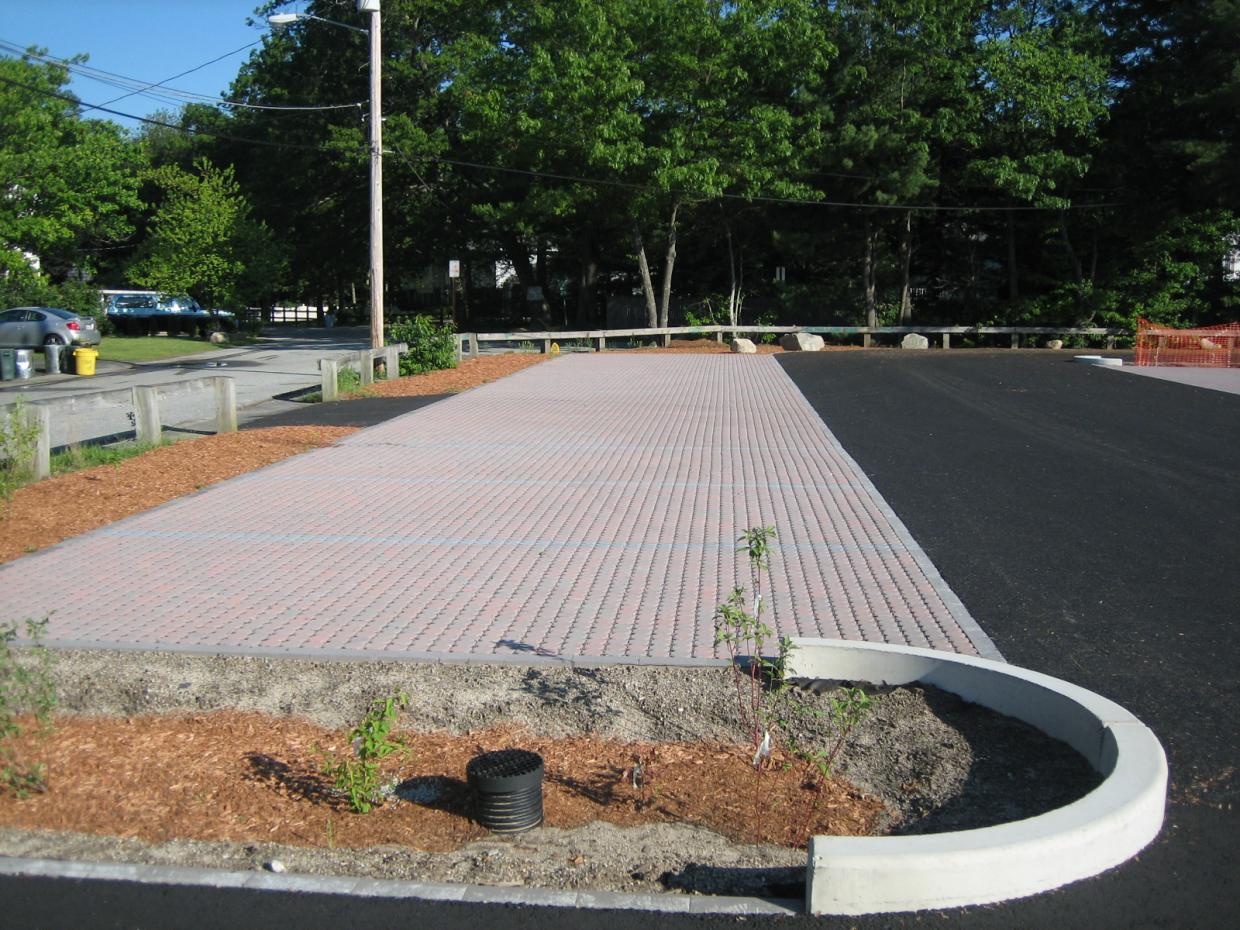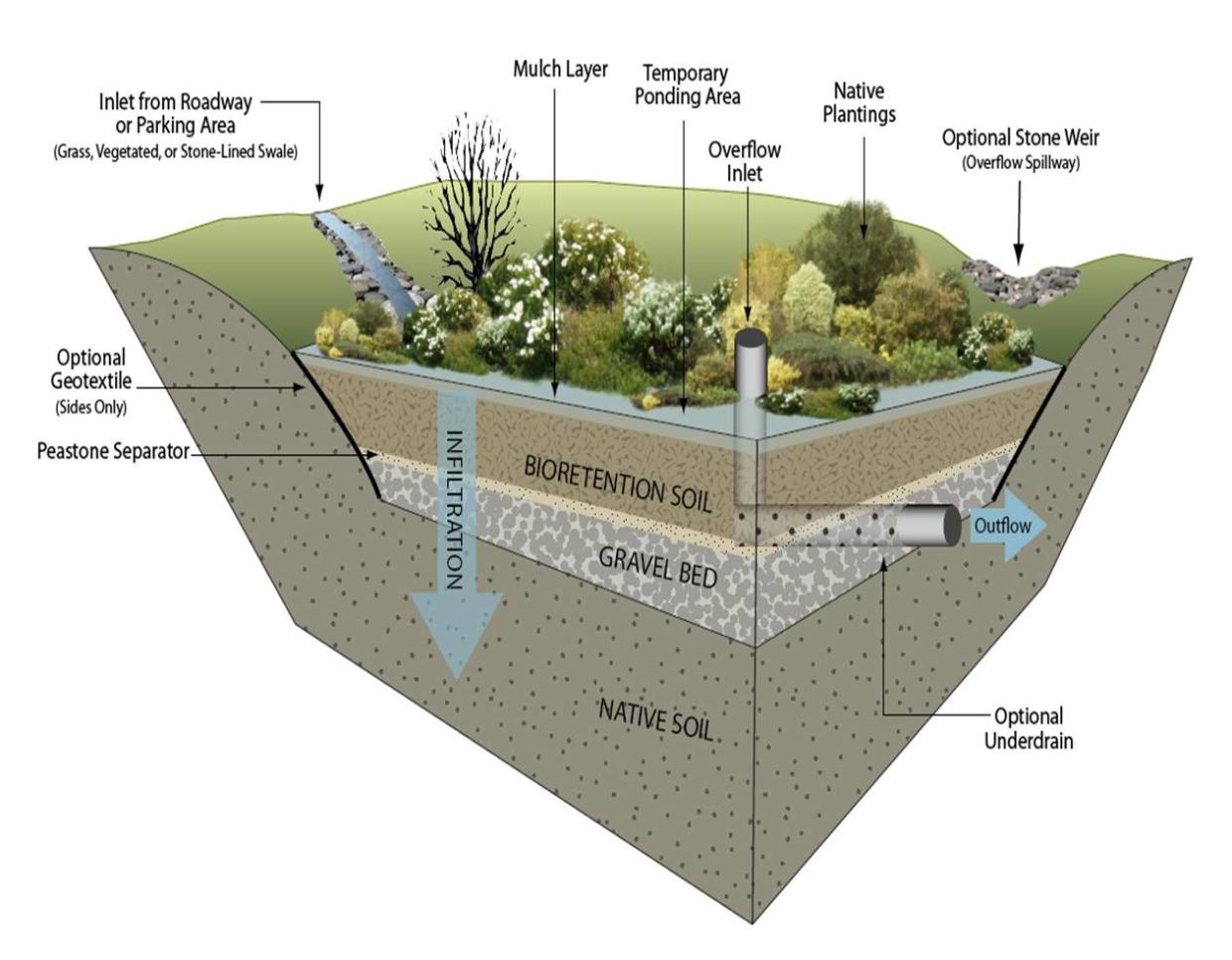Project Description
Location: Silver Lake Beach Parking Lot, Wilmington MA
Purpose:
- Reduce the quantity of stormwater runoff and nonpoint source pollutionto Silver Lake and maximize infiltration to groundwater.
- Demonstrate the use and performance of different types of permeable paving materials.
- Demonstrate the use of bioretention cells to reduce runoff and pollutants from impervious surfaces.
- Assess and characterize any potential impacts to groundwater quality that might result from the use of permeable pavement.
Details: Silver Lake is an important recreation area that supports swimming, fishing, wildlife viewing, and boating. However, the lake’s quality was deteriorating from nutrients, sediment, and bacteria entering the lake from the surrounding stormwater system (which includes several pipe outlets to the lake) and nonpoint source runoff. Beach closures due to high bacteria counts had occurred repeatedly for many years prior to this demonstration.
This project incorporated three low-impact development (LID) practices designed to reduce runoff volume, improve water quality, and enhance groundwater recharge:
Four types of permeable paving materials were used to repave about half of the parking lot. The parking spaces themselves, consisting of about 8,000 square feet, were paved with porous pavers, which allow stormwater to soak into the ground between the paving units. The parking aisles, consisting of 16,600 square feet, were paved with porous asphalt, a special mix that allows water to pass through the pavement surface. Underneath the porous pavers and asphalt is an infiltration bed of crushed stone that filters contaminants and allows water to slowly percolate into the underlying soil. Additionally, a porous paving system called Gravelpave, consisting of interlocking plastic cells filled with gravel, was installed in a portion of the overflow parking area. Finally, a porous material called Flexi-Pave, made from recycled tires, was installed in another small section of the overflow parking lot. For comparison purposes, one half of the existing main parking lot was resurfaced with standard asphalt.
Surface runoff from the standard pavement and any overflow from the permeable paving surfaces was designed to drain to bioretention cells, which will provide treatment as water percolates through the soil, and nutrients and contaminants are processed by the plants. The parking lot design included two center bioretention islands and seven bioretention cells around the perimeter.
Two ten-foot-wide vegetated water quality swales were installed to replace existing piped stormwater outfalls at either end of the beach. As with the bioretention cells, these swales were designed to improve water quality through the physical, chemical, and biological processes that occur as runoff is exposed to sunlight, percolates through soil and is taken up by plants. The northwestern swale replaced a grassed area that formerly attracted geese and other waterfowl, leading to the buildup of droppings that contributed to bacteria loading and closure of the public swimming beach area. The planting plan for this swale includes native shrubs that are not attractive to grazing waterfowl.
Project partner: Town of Wilmington
Design/Engineering/Construction oversight: Geosyntec Consultants
Construction and three years of maintenance: Cali Corporation
Monitoring and Analysis: U.S. Geological Survey
Ongoing Maintenance: Wilmington Department of Public Works
Acknowledgements: DCR would like to acknowledge contributions to this project from Invisible Structures, Inc. (porous asphalt), K.B. Industries (Flexi-Pave) and Oldcastle/Foster-Southeastern (permeable pavers)
Site Photos and Aerial Schematic
Milestones
- Construction of pavement and installation of planting materials completed May 2006
- Monitoring of groundwater quality conducted by USGS:
- Preconstruction sampling: July - October 2005
- Postconstruction sampling: June 2006 - June 2007
Costs
Design/engineering/construction management (combined costs for Demonstration # 3 and # 4): $92,000
Construction, and three years of maintenance (combined costs for Demonstration # 3 and # 4): $355,000
Data Collection and Analysis
The U.S. Geological Survey (USGS) installed seven wells in the parking lot. Four wells provided data on groundwater levels, and three provided data on groundwater quality. USGS monitored preconstruction conditions after five storms over four months. Following construction, USGS monitored groundwater levels and collected samples monthly. Samples were analyzed for a range of parameters including:
- conductivity
- temperature
- pH
- nitrogen
- phosphorous
- metals
- total petroleum hydrocarbons
Sampling was designed to detect any changes in groundwater quality associated with recharge from the parking lot.
This project was closely coordinated with additional LID work occurring across the lake from the town beach. For details, see Demonstration 4: Stormwater Quality Improvements Using LID Retrofits in Lake-Side Neighborhood
Key Results and Conclusions
-
Infiltration tests of the permeable paving materials, conducted after construction, indicated that infiltration rates met or exceeded specifications; the average observed infiltration rates were:
|
Porous Asphalt |
Permeable Pavers |
Flexi-Pave |
Gravelpave |
|
69 in./hr. |
49 in./hr. |
1,492 in./hr. |
exceeds 5,000 in./hr |
-
Results of monitoring showed no indication of groundwater impairment beneath the areas with pervious paving.
-
Reports from the town Board of Health show no closures of the swimming beach as a result of E. coli bacteria for at least four years following installation of the LID features. For eight years prior to installation, beach closures due to E. coli occurred one or more times each summer.
-
Since the installation of the LID features, the beach had one closure due to cyanobacteria, an algal bloom often associated with in influx of nutrients.
Publications
- USGS Scientific Investigation Report 2010-5007
- USGS circular
- Silver Lake Interpretive Sign
- Ipswich River Targeted Watershed Grant Fact Sheet: Three Low-Impact Development Case Studies
- Town's Maintenance Protocol
- Project brochure sent to all town residents
- Roy, Steven P. and Andrea Braga. February 2009. Saving Silver Lake. Civil Engineering—ASCE, Vol. 79, No. 2, pp. 72-79.

